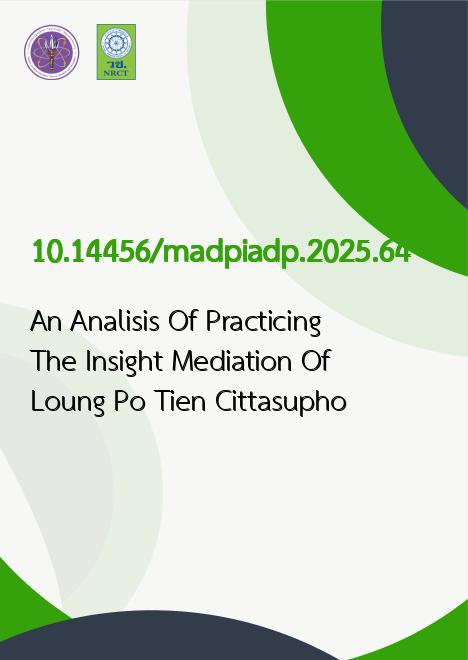
|
An Analisis Of Practicing The Insight Mediation Of Loung Po Tien Cittasupho |
|---|---|
| รหัสดีโอไอ | |
| Creator | Phrasumet Sumedo (Saingam) |
| Title | An Analisis Of Practicing The Insight Mediation Of Loung Po Tien Cittasupho |
| Contributor | , Boonsong Sinthunok, Phamaha Prateep Abhivatdhano, Arithat Loesruamchok |
| Publisher | DR.KET Institute of Academic Development and Promotion |
| Publication Year | 2568 |
| Journal Title | Modern Academic Development and Promotion Journal |
| Journal Vol. | 3 |
| Journal No. | 2 |
| Page no. | 612-629 |
| Keyword | Practice, Vipassana Meditation, Luangpor Teean Jittasubho |
| URL Website | https://so12.tci-thaijo.org/index.php/MADPIADP/ |
| Website title | https://so12.tci-thaijo.org/index.php/MADPIADP/ |
| ISSN | 2822-1095 |
| Abstract | Research Objectives This research aims to (1) Study the practice of Vipassana meditation as found in the scriptures of Theravāda Buddhism (2) Examine the Vipassana meditation practice according to the approach of Luangpor Teean Jittasubho. (3) Analyze the Vipassana meditation approach in Theravāda Buddhism as taught by Luangpor Teean Jittasubho. Research Methodology This qualitative research collected data from documents and interviews with 34 key informants. Data was gathered using structured interviews and analyzed through comparative analysis to identify relationships between the findings.Research Findings1. Vipassana Meditation in Theravāda Buddhist Scriptures The study found that Vipassana meditation involves cultivating insight into the five aggregates (khandhas) through the three universal characteristics: impermanence (anicca), suffering (dukkha), and non-self (anattā) to detach from self-clinging. There are three main approaches: (1) Samatha leading Vipassana, (2) Vipassana leading Samatha, and (3) a combined practice of both. The Four Foundations of Mindfulness (Satipaṭṭhāna) serve as the core framework, while the Ten Great Insights (Mahāvipassanā) in the Visuddhimagga emphasize the contemplation of impermanence, suffering, and non-self. Momentary concentration (khanika-samādhi) acts as a foundation for insight knowledge (ñāṇa), leading to detachment and ultimate liberation (vimutti).2. Vipassana Meditation According to Luangpor Teean Jittasubho Luangpor Teean’s method emphasizes rhythmic hand movements to cultivate self-awareness, rather than stillness or tranquility-based meditation. The practice is done with open eyes, without chanting or reciting mantras, and focuses on observing thoughts without suppressing them. Continuous effort (viriya) and clear comprehension (sampajañña) help the mind awaken, leading to correct awareness of thoughts, which naturally cease on their own. This method trains spiritual faculties (indriya), develops wisdom (paññā), and eliminates attachment to the five aggregates, ultimately leading to liberation. Awareness is practiced in all postures—walking, standing, sitting, and lying down—until the practitioner realizes inner Buddhahood and progresses toward the state of an enlightened being (ariya).3. Analysis of Luangpor Teean Jittasubho’s Vipassana Approach in Theravāda Buddhism The analysis highlights the distinction between “knowing” (rú) and “seeing” (hēn). Knowing involves engaging in thoughts, whereas seeing allows one to detach from them. Through continuous observation of thoughts, a sudden inner transformation occurs. "Knowing thoughts" is considered ignorance (avijjā), while true wisdom (vijjā) arises when one distinguishes between knowing and seeing. Thought itself is the cause of suffering (samudaya), while the path (magga) is to use mindfulness (sati) to observe thoughts immediately without clinging—allowing them to cease naturally. This process is called Vipassanā-ñāṇa (insight knowledge), which eradicates defilements and leads to Nirvāṇa. |